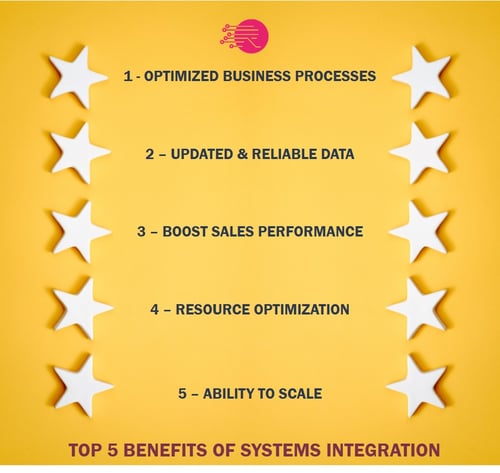salesforce and erp integration
System integration has become a relevant topic for most IT leaders worldwide. Why? Simply because companies have invested in a range of small and large systems to increase productivity and streamline operations.
While this original digital transformation was a great first step, it was not enough. To fully leverage their investment in these systems, companies need to connect them together. Only then will they reap all the benefits from their initial system investment. They need to control these systems and the data they collect.
How to do system integration and who can help you integrate your systems? This article will consider the true benefits of system integration. It will also give you tools to select the best solution for your company.
What is system integration?
Simply put, the idea behind software system integration is to link together a company’s various IT systems and platforms. The purpose is to have them work as much as possible as one IT system, thereby avoiding silos of data.
Is system integration important? According to a California-based market research made by Grand View Research, the global system integration market was valued at $234 billion in 2015 and is expected to reach $530 billion by 2025.
Companies are using a growing number of systems and software applications to collect information about their customers. As a result, they collect large amounts of data and they need to make sense of it.
Nowadays, most companies rely on a wealth of information systems to support their business operations. These could be Management Information Systems, Decision Support Systems, Transaction Processing Systems, etc. Most organizations today use at least an ERP (Enterprise Resource Planning) system and a CRM (Customer Relationship Management) system. If these systems are not integrated, there is no single version of the truth in a company.
Integrating systems such as a CRM system and an ERP system allows staff to have reliable data. They are sure that they are working with one single truth and a full 360 view of their customers and vendors.
What is the main role of system integration?
At the age of big data and artificial intelligence, digital transformation initiatives are often a major part of a company’s strategic vision. IT leaders all over the world are looking for ways to optimize business processes. Digital technologies are often a big part of the solution.
System and application integration solutions connect IT systems and subsystems together. It could be different cloud-based solutions, on-premise solutions, or a mix of on-premise and cloud applications.
The essential role of system integration in digital transformation
You might wonder how important system integration is for digital transformation. Originally, digital transformation has been about the adoption of digital technology to replace traditional, often manual processes.
In the past decades, most companies have invested in systems and applications such as ERP, CRM, and many others to streamline their business processes. This initial digital transformation has revolutionized the way companies can service their customers and grow their commercial operations.
Today, digital transformation often means connecting diverse legacy systems to make them work as one. This way you can get one true version of a company’s data. This is another revolution, taking the business process optimization to yet another, higher level. Customer experience has never been better.
Key benefits of system integration
System integration takes business process optimization to the next level. It removes the inefficiencies and gaps created in environments where systems are isolated silos. There is a huge ROI (Return on Investment) potential in system integration.
These are some of the other benefits you can gain from integrating your systems:
- Streamline and optimize business processes: When your business processes are fully automated and the information flows between your system, your employees are more efficient. They take informed decisions and take customer satisfaction to the next level.
- Access to up-to-date information: When you benefit from real time system integration, you are never in doubt whether you have correct customer information.
- Increased sales: When your sales staff is equipped with all the customer information they need, they provide better advice to them regarding a next purchase.
- Resource optimization: Automating the flow of information between systems will drastically cut the amount of manual work to transfer information from one system to another. You will be able to cut resources or to re-allocate resources to other, more productive tasks.
- Ability to scale: When your systems are integrated, you do not worry about getting even more data. You are ready to grow your operations to their full potential.

Which are the best system integrators?
When you have understood the key benefits of data integration, the next challenge is choosing an integration system. This is not necessarily an easy task as there are many system integration software providers on the market.
Selecting the right system integrator is a vital step for the success of your system integration project. A good start is to select a vendor that has deep knowledge and experience with the systems you wish to connect.
A great part of all data integration projects have common ground. The difficult part, however, is always hidden in the details that make each application unique. For example, if you are integrating Salesforce with Microsoft Dynamics, choose a vendor that is an expert in:
- data integration
- Salesforce
- Microsoft
This is the best way to secure a successful implementation.
It is therefore difficult to publish a generic list of the best system integrators. A system integrator might claim to be able to connect any systems with each other. However, is it possible for them to be experts within any systems?
They might be experts in data transfers. However, they might come across unexpected problems when they attempt to integrate two completely new systems. Choosing true experts is the safest way forward, especially if you have made customizations to your systems.
Rapidi published a list of the best Salesforce system integrators, including a comparison of their key benefits and pricing model. You can learn more about it here.
Learn more about system integration
If you would like to learn more about how approach your system integration project, read this ebook:

Small system integration glossary:
As you enter the world of system integrators, you will come across many specific terms and other concepts. Here is a quick list of the most common terms.
Vertical Systems Integration
In a vertical integration scenario, you create “silos” of functional entities where your systems are related according to a function.
Horizontal Systems Integration
In an horizontal integration scenario, you will create a subsystem that will serve as a unique interface for all the systems you wish to integrate. This approach can also be called Enterprise Service Bus (ESB).
Star Systems Integration
Star Integration can also be referred to as “spaghetti” integration. It looks a bit like a dish of spaghetti with interconnections and each system being connected to multiple other systems.
Point-to-point Systems Integration
Point-to-point integration is a simple, one to one integration between two endpoints. It works well when mapping from one system to another but becomes quickly limited if you wish to integrate many systems.
Hybrid Integration Platform
A hybrid systems integration platform (also called HIP) allows companies to integrate their on-premise systems with their Cloud-based applications.
Common Data format
The Common Data Format (also known as CDF) was created by NASA in order to store and manipulate large amounts of multi-dimensional data.












